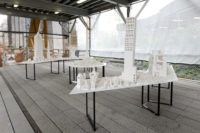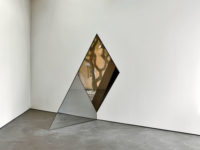Katrín Sigurdardóttir was born in Reykjavik and moved to the United States in 1988 to attend the San Francisco Art Institute. The artist now splits her time between studios in Long Island City, New York, and Iceland. As it is in her life, a kind of diasporic mobility is a key theme in Sigurdardóttir’s work. “I’ve had this fantasy of taking a place and somehow attempting the impossible of having it move,” she says. She does this with Foundation. Inspired in part by 18th-century architecture and construction, Foundation is a fragment of an imaginary pavilion, but also a distinct place in and of itself. It was conceived to travel, beginning as the Icelandic Pavilion at the Venice Biennale in 2013 and installed in the Palazzo Zenobio, where it intersected with the walls of an historic laundry. Then it was moved to the Reykjavik Art Museum and was most recently on view at the SculptureCenter in Long Island City. While architects typically draw buildings that do not yet exist, Sigurdardóttir creates spaces that come with a rich, layered “history” of her own making. Her process “is akin to the way an architect or spatial designer would think, but also the way an archeologist would work,” she says. Like an aging monument, Foundation’s handmade tile surface now has a scuffed patina from thousands of visitors, and a rough underbelly that roots the sculpture in reality.
Katrín Sigurdardóttir

Foundation is a fragment of an imaginary pavilion, but also a distinct place in and of itself.
Photo: © Orsenigo Chemollo, courtesy of the artist and the Icelandic Art Center

Foundation was conceived to travel, beginning as the Icelandic Pavilion at the Venice Biennale in 2013 and installed in the Palazzo Zenobio, where it intersected with the walls of an historic laundry.
Photo © Ron Amstutz, courtesy Katrín Sigurdardóttir

Foundation, 2013-2014
Photo © Orsenigo Chemollo, courtesy of the artist and the Icelandic Art Center

Foundation, 2013-2014
Photo © Petur Thomsen. Courtesy of the Artist and the Reykjavik Art Museum.

Foundation, 2013-2014
Photo © Ron Amstutz, courtesy of the artist




Post a comment to this article
Report Abusive Comment